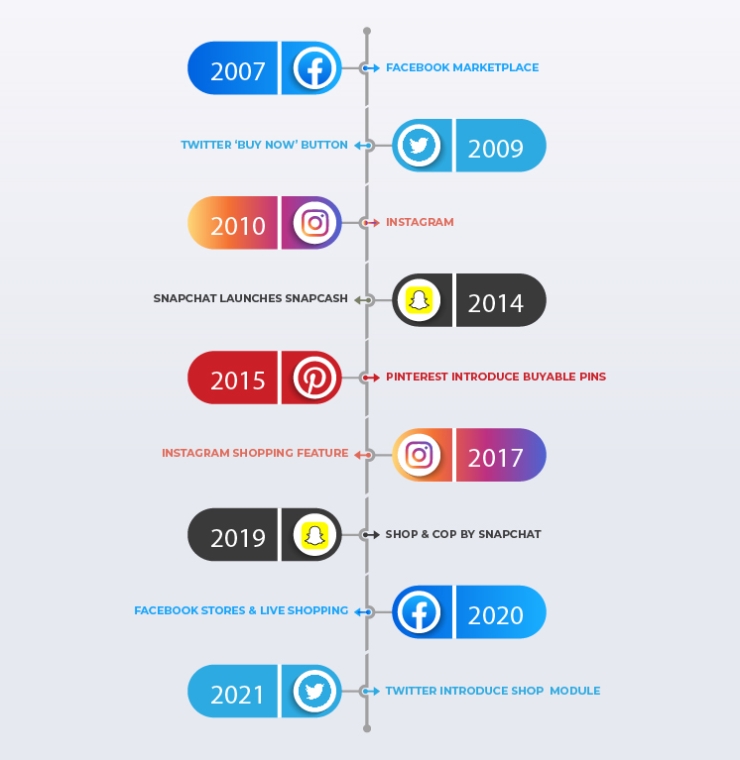Have you ever imagined changing every swipe, like, and share into actual sales for your business? Sounds like a scene from a sci-fi movie? No, but it is a reality that comes to life and causes a prominent revolution in e-commerce.
Social Commerce is the reality that changes the dynamics of businesses operating from e-commerce platforms. It bridges the gaps between social media and e-commerce, providing an extraordinarily excellent user experience.
“In 2022, Social commerce generated $724 billion in global revenue and is set to exceed $6 trillion by 2030.”
Utilizing this approach as a social commerce app can skyrocket any business success because billions of people use social media platforms. So it will make it easy for businesses to target a vast audience of more significant demographics and accelerate their sales rate exponentially.
So, if you are a business owner or entrepreneur who wants to expand your business reach with a social commerce app, we bring this comprehensive guide to equip you with all the details you might need to develop a social commerce app.
Ready? Let’s dive in!
What is Social Commerce? – Infusion of Social Media & eCommerce
Social commerce is the mixture of e-commerce and social media that allows businesses to provide an excellent shopping experience by incorporating social interaction, user-generated content, and social recommendations.
Combining the power of social networking sites and e-commerce platforms lets the user search, share, and purchase any product directly from the social platform. To further enhance your social commerce strategy, consider exploring social media post ideas that resonate with your target audience.
The Evolution of Social Commerce
Social commerce traces can be found in the early days of the Internet when people started connecting through social communities, and these communities allowed them to share interests, sell products, and provide feedback to each other.
However, social commerce trends have become popular since social media started evolving with technological advancements. Now, it has become a unique platform for businesses to sell their product.

How is a Social Commerce App Different from an E-commerce App?
Many individuals take social commerce apps and e-commerce apps as the same things, but both have many differences on different levels. Here are the key differences:
➔ Social Elements Integration
E-commerce apps mostly lack social elements, as their primary focus is facilitating transactions and product listing.
Social commerce platforms allow the integration of social media functionality and features, letting users share products with others, ask for reviews and recommendations, and then make a purchase.
➔ User Experience
eCommerce platforms prioritize simplicity and efficiency while focusing on user-friendly navigation and a simple purchasing process.
On the other hand, social commerce uses interactive approaches to provide an engaging customer experience by prioritizing visually appealing interfaces.
➔ Product Discovery
Avoiding the components needed to enhance the exploration and functionality of finding e-commerce platforms relies on simple search functionality and filters.
Conversely, social commerce worked on algorithms and personal recommendations based on customers’ preferences and social interactions.
➔ Social Engagement & Interaction
Without emphasizing the social aspect of shopping, e-commerce platforms primarily focus on transactions, whereas social e-commerce fosters social engagement and interaction among users.
How to Develop a Social Commerce App?
As discussed above, social commerce is now the new normal in e-commerce. From opening new opportunities for businesses and entrepreneurs to offering customers an excellent shopping experience, social commerce apps evolve the shopping experience.
After understanding the benefits of social commerce, you also want to develop an app for your business. Well, it’s not an impossible task; you can design a user-friendly and engaging app easily. Let’s get into detail how you can do it.

1. Define Goals & Objectives
The first step you must be clear about before developing your app is the purpose of it, like whether you are going to use it to create an uninterrupted connection between business and customers, or you want to target any specific market, or if it is going be a typical platform where an influencer can show their product.
Development totally depends on your goals and objects. So be specific and clear about your purpose, target audience, and preferences, as this will help you improve and make the designing process smooth.
2. Choose a Platform
Selecting a platform for your social commerce app is one of the essential steps to ensure success. By considering the factors, including functionality requirements, target audience, budget, and scalability, you can decide whether you want a native app for iOS or Android or go for cross-platform builders to cover more significant demographics.
Assess the benefits and drawbacks of both platforms and go with the right call based on your requirements.
3. Plan and Design the User Experience
The social commerce app user experience matters the most as it involves continuous engagement and seamless interaction. So, working with professional designers will be beneficial to get an easy-to-use and aesthetically appealing interface.
Plan user flows, wireframe app screen, and design intuitive navigation. Include features that improve the social aspect of your app, like profile creation, reviews, rating, and social sharing capabilities.
Always opt for a simple yet personalized app design that perfectly aligns with your branding and potential customer expectations.
4. Time to Develop App
Now the planning and designing step is completed, it’s time to develop your app. There are many options available to build your app.
You can opt for a professional app development service, or if you are using a WordPress website, you can easily use any app development plugin to get a professional-looking app, which makes the app development process easy and efficient.
If you’re looking for top-tier talent to bring your vision to life, Toptal is a trusted platform where you can hire a mobile app developer with the expertise to create a high-quality, customized app efficiently.
5. Integrate Payment Gateway
One of the most important things that make the user experience more pleasurable is the option of smooth payment, which can only be possible with the integration of payment gateways.
Search the market and choose the one that offers diverse payment methods that go well with your target audience. Also, ensure payment protocols, encrypt user data, and comply with industry regulations and standards.
6. Test, Optimize & Refine
Now, you have your own social commerce app with integrated payment gateways. So you must be thinking, what are we waiting for?
Before launching, testing your app is the most necessary part as it helps you detect bugs at different stages of your app and lets you fix them before final launching. To ensure the app’s reliability and functionality, beta testing can be a great idea to get valuable insights.
After testing, continuously optimize and refine the app based on user feedback, analytics, and industry trends.
7. Launch, Market & Monitor
Your app is designed, tested, and optimized, ready to launch and boom the market. So, to let your target audience know about your app, develop a marketing strategy that guarantees success in creating awareness, attracting users, and driving easy adoption.
Use social platforms, email marketing, or targeted advertising to make your app reach your target audience. Also, monitor user engagement, retention rates, and translation to gain insight and make data-driven decisions.
Latest Social Commerce Trends
Since then, social commerce has become popular. It constantly evolves with the emergence of trends, reshaping how customers interact and shop. Recently, we have witnessed an increase in innovative social commerce trends that boost the social shopping experience.
Let’s explore some of the latest social commerce trends.
➔ Integration of Augmented Reality
Augmented reality’s introduction has shown an influencing effect on every part of life, including social commerce. This social commerce trend changes how people shop and how businesses interact with consumers.
If we talk about how AR reforming social commerce dynamics, it makes testing or trying products virtually a reality. Just suppose you like any piece of furniture but are confused about whether it will fit your current setting.
AR solves this: it lets you visualize furniture in the home setting so you get a better idea and purchase according to yours. Even trying clothes virtually is now possible with AR.
This level of modernization provides customers room to make sound decisions without leaving their couches, helping businesses improve customer satisfaction and boost sales.
➔ Live Shopping
Live shopping has witnessed significant growth as it involves real-time interactive video broadcasts. It allows sellers to demonstrate their products to potential customers, answer their queries, get feedback, and do the deal spontaneously.
This social commerce trend involves the power of social media and influencers to help businesses offer engaging yet entertaining shopping experiences.
➔ Personalization and AI Recommendations
Personalization and AI recommendations are also emerging social commerce trends by collecting user data, including choices, behavior, and interaction on social media. With this data, an AI algorithm offers customized recommendations based on individuals’ interests.
It lets customers explore products that match their interests and minimize the fatigue of making wrong decisions.
Conclusion
The way social commerce innovates the shopping experience, it’s now necessary for every business to have a social commerce app. Therefore, to develop it, you need careful planning, execution, and support.
Along with it, if you embrace the steps mentioned in this blog to develop a social commerce platform, you will be good to create an app that helps you distinguish your brand from competitors and quickly get the target audience’s attention.
Also, you can redefine the ways of shopping your customers follow and let them enjoy the best shopping experience from the comfort of their homes.

